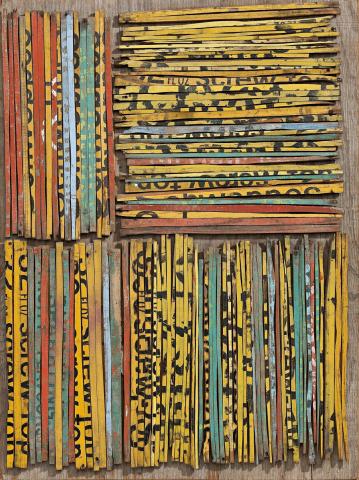SUMMER STACK, 1990
ROSALIE GASCOIGNE
sawn soft drink crates on plywood mounted on board
91.5 x 69.0 cm
signed, dated and inscribed verso: SUMMER STACK / Rosalie Gascoigne / 1990
Pinacotheca Gallery, Melbourne
Private collection, Sydney
Deutscher~Menzies, Sydney, 16 June 2004, lot 56
Private collection, Sydney
Rosalie Gascoigne, Pinacotheca Gallery, Melbourne, 17 April – 11 May 1991, cat. 7
Circle Line Square: Aspects of Geometry, Campbelltown City Art Gallery, New South Wales, 16 September – 21 October 1994; Newcastle Region Art Gallery, New South Wales, 16 December 1994 – 29 January 1995; Albury Regional Art Centre, New South Wales, 28 April – 28 May 1995; New England Regional Art Museum, New South Wales, 4 – 27 August 1995
Zimmer, J., Circle Line Square: Aspects of Geometry, Campbelltown City Art Gallery, New South Wales, 1994, p. 18
McDonald, V., Rosalie Gascoigne, Regaro, Sydney, 1998, p. 106
McCulloch's Encyclopedia of Australian Art, The Miegunyah Press, Melbourne, 2006, p. 453 (illus.)
Although universally regarded as one of the most significant Australian artists of the twentieth century, remarkably Rosalie Gascoigne did not hold her first exhibition until the age of 57. Immediately attracting the praise of collectors and critics alike, she was soon offered a major survey exhibition at the National Gallery of Victoria (1978) and in 1982, was selected to represent Australia at the Venice Biennale (alongside Peter Booth), being the first Australian woman to receive this honour. In more recent years, she has featured in numerous important and international exhibitions - including the prestigious solo exhibition show Material as Landscape held at the Art Gallery of New South Wales and National Gallery of Australia (1997- 98) - and today is represented in all major collections in Australia and New Zealand, as well as the Museum of Modern Art, New York.
Of all Rosalie Gascoigne's achievements, undoubtedly the most striking and widely celebrated are her assemblages such as Summer Stack, 1990 constructed from weathered wooden Schweppes soft drink crates, sliced into thin uneven slivers with a bandsaw. Like many other compositions from this highly acclaimed series, including the monumental Monaro, 1989 (Art Gallery of Western Australia), the present draws its inspiration from her immediate surroundings, namely the spacious grazing lands of the Monaro region near Canberra. Accordingly, the rhythmic arrangement and tonal variations of the wooden slivers here allude to the crisscross patterned haystacks so characteristic of this agricultural locale - the transient shadows and play of light evoking a strong sense of place, of the timeless spirit of the landscape. Profoundly lyrical and refined yet always maintaining a close proximity to the outside world, Gascoigne's sensibility of place is thus, paradoxically, 'both nowhere and everywhere at once'.1
As Martin Gascoigne elucidates, '... her work was very much about recollected feelings or emotions, especially in relation to the landscape around Canberra. Her works touched on all aspects of that landscape, its changing look with the changing seasons, its varied topography, and the traces of its history and use. Summer Stack can be seen in this context. In the same period, she made a number of works that reflect this, including Wheat Belt, 1989 and Stooks, 1991-92.2
Having eschewed the use of iconography, Gascoigne favours allusion and suggestion so that her work might 'speak for itself' as art, awakening '... associations that lie buried beneath the surface of consciousness; inviting a higher degree of sensitivity and attentiveness to the world around us.3 Indeed, it is this higher awareness, the ability to recognise beauty in the most humble of materials that Gascoigne demands of her audience. For, as the eye moves through this artful arrangement searching for information and the mind attempts to place different rules of perspective or build upon the suggestion of the marks, 'in time we realise that the only solution is to stop trying to navigate through the forest of symbols, and enjoy the beauty of the trees.'4
1. Cameron, D., What is Contemporary Art?, exhibition catalogue, Rooseum, Malmo, Sweden, c.1989, p. 18
2. Gascoigne, M., in correspondence with Damian Hackett, 2004
3. McDonald, J., 'Introduction', MacDonald, V., Rosalie Gascoigne, Regaro, Sydney, 1998, p. 7
4. Ibid.
VERONICA ANGELATOS
